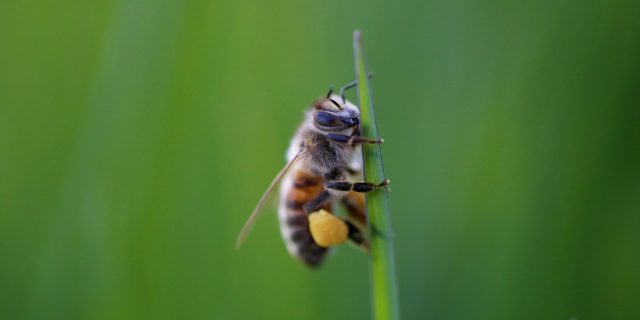22
Feb
Neonicotinoids Combined with Other Pesticides Elevate Hazards to Honey Bee

(Beyond Pesticides, February 22, 2023) Combining neonicotinoid insecticides with other commonly used pesticides can result in synergistic effects on honey bees, increasing toxicity more than any individual chemical could, according to research published in Scientific Reports earlier this month. The data highlight the grave inadequacy of the U.S. Environmental Protection Agency’s (EPA) process for evaluating pesticide risks. Under current regulations, EPA requires chemical manufacturers to submit data only on singular active ingredients. Yet, pesticide products may be packaged or ‘tank mixed’ with other, equally toxic pesticides without any obligation to determine the toxicity of the material that is actually being applied. Independent research is left to fill in these gaps, and the data increasingly shows that toxicity with pesticide mixtures amounts to a roll of the dice: sometimes combinations are less toxic, sometimes their toxicities are merely additive. But more often than not, pesticide mixtures result in synergistic effects that make the product significantly more toxic than either individual chemical alone.
To understand how pesticide combinations are harming pollinators, scientists began with baseline data on the individual toxicity range that common pesticides pose to honey bee colonies. Research was conducted on honey bees reared in the Stoneville Wildlife Management Area in Mississippi, with each colony containing a healthy egg-laying queen and nine frames of comb with honey, pollen, larvae, and pupae. Toxicity was measured by the lethal concentration that killed more than 50% of exposed pollinators after two days of treatment in a sugar solution. Among the eight pesticides tested, honey bee toxicity was as follows from most to least toxic: the neonicotinoid insecticide thiamethoxam, the organophosphate insecticide dimethoate, the carbamate insecticide methomyl, the synthetic pyrethroid insecticides permethrin, and then cypermethrin, the triazole fungicide tetraconazole, and the synthetic pyrethroids cyfluthrin and then esfenvalerate. These results did change based on different treatment lengths, yet thiamethoxam was found to remain the most toxic throughout all studies.
In the study, scientists evaluate a total of 98 different mixtures, from binary combinations of two different chemicals to octonary combinations of all eight different pesticides. Within these tests, approximately 30% of these were found to be synergistic to honey bees, exhibiting toxicity greater than each individual material in the mixture. Only 18% of these combinations were antagonistic, and presented lower risks to the pollinators.
Perhaps the most concerning interaction came from combinations that included thiamethoxam and the fungicide tetraconazole. Any variation of pesticide combinations that include these two chemicals have a roughly 55% chance of exhibiting synergistic toxicity to honey bees. “In other words, the synergistic interaction between THI [thiamethoxam] and TET [tetraconazole] could transcend the effect of the additive or antagonistic interactions among other pesticide combinations,” the study notes.
This is not the first time tetraconazole has been implicated in generating synergistic toxicity. A study by the same authors of another neonicotinoid, acetamiprid, found similar results when combining that neonicotinoid with tetraconazole.
It is also important to note that this study focuses on the acute toxicity of these pesticide combinations to pollinators; it does not capture chronic or sublethal impacts, on which there is a broad body of scientific literature showing harm that can eventually result in the deaths of individual pollinators or even the collapse of entire colonies. The authors note this limitation in their discussion, indicating that, “Apart from lethal effects, some reports have demonstrated that exposure to field-realistic concentrations of neonicotinoids can exert sub-lethal effects on the bees. Therefore, it is necessary to conduct chronic determinations for pesticide exposure in the pollination insects…some studies have shown that neonicotinoids have time-dependent and time-cumulative effects, so that the risk of foraging bees feeding on small levels of residues becomes an unignorable issue. This means that these pesticides can cause effects at any level if the exposure duration is sufficient. Therefore, the traditional risk assessment method can not predict the influences of neonicotinoids on the environment.”
It is indeed the traditional risk assessment process that is now failing pollinators. Beekeepers and managed honey bees continue to experience devastating losses, while wild pollinators like the American bumblebee and Monarch butterfly flirt with extinction. It is clear that neonicotinoids are harming pollinators; as DDT was to birds of prey neonicotinoids are to pollinators. These species are the bald eagles and osprey of our time. It is now commonly knowledge that the reason why we now see increasing populations of these animals are because we protected them from toxic pesticides when it was most needed.
Join in telling Congress that the nation’s pesticide law needs real reform. Not only must we stop the ongoing use of neonicotinoids, we must prevent the next DDT, and the next neonicotinoids from ever coming to market in the first place.
All unattributed positions and opinions in this piece are those of Beyond Pesticides.
Source: Scientific Reports











we need bees
February 22nd, 2023 at 5:39 pm